Well that just depends. I have no experience with plated diamonds on steel, but I do know they are in a league of their own as far as being the most aggressive bond possible. I would think the Atoma would be the pick for serious metal removal but don't quite apex with it. The Venev F150 I would also advise not to apex with as it leaves a honkin big burr, which will take the apex off when you break the burr off. I got ahold of a Maxamet Spyderco from DeadboxHero last Monday and after sharpening it I am feeling a lot better about the Matrix 300. It is not the fastest stone but it will still cut fine using just the weight of the stone and arm. This free cutting action with very little pressure lets it apex with a very small burr for it's grit, using only edge trailing strokes. I am really thinking the Matrix stones niche is their ablility to sharpen a high quality edge. I have a few reviews in the works and will post them when I have time to get them finished.
-
The BladeForums.com 2024 Traditional Knife is available! Price is $250 ea (shipped within CONUS).
Order here: https://www.bladeforums.com/help/2024-traditional/
You are using an out of date browser. It may not display this or other websites correctly.
You should upgrade or use an alternative browser.
You should upgrade or use an alternative browser.
Edge Pro Matrix resin bond diamond stones
- Thread starter Diemaker
- Start date
Review of sharpening a Spyderco Maxamet knife with the Matrix stones.
Thanks again to DeadboxHero for letting me have this knife for a few days so I could sharpen it. This is the first time I have sharpened anything harder than 440c ish blades, other than ceramic. Short version is it's a little slow to set the bevel but once that is done the rest goes just a bit slower than what I am used to. The finished results are spectacular!!!! I flat LOVE this steel. VERY hard, fine grained, and pretty much no microchipping which I find interesting since I usally have some with my other knives if I am not careful.
Ok, now the long version. I started out setting my Apex at 21 degrees and began grinding away with a little pressure, about double the weight of the stone and arm, with bidirectional strokes. Before I reached the apex I tried a 320 Alox stone just to see for myself what it would do, which was nothing. Back to the Matrix 300 but once I started rasing a burr I noticed some damage at the apex with coresponding scratches in the bevel so I switched to edge trailing strokes. Once I was getting a burr along the length of the blade I played with getting the best edge possible by using only the weight of the stone and arm and making only 7-10 passes per side of the blade. This made a big difference in the integrity of the apex and the size of the burr, it got really small considering it is a 300 mesh, 80 micon, stone.
Bi-directional passes on the right, edge trailing on the left. Notice the scratches leading to the edge damage on the bi-directional passes from edge leading strokes. This is pretty common, in my experience, which is why I use edge trailing strokes. The bevel is about .075" wide.
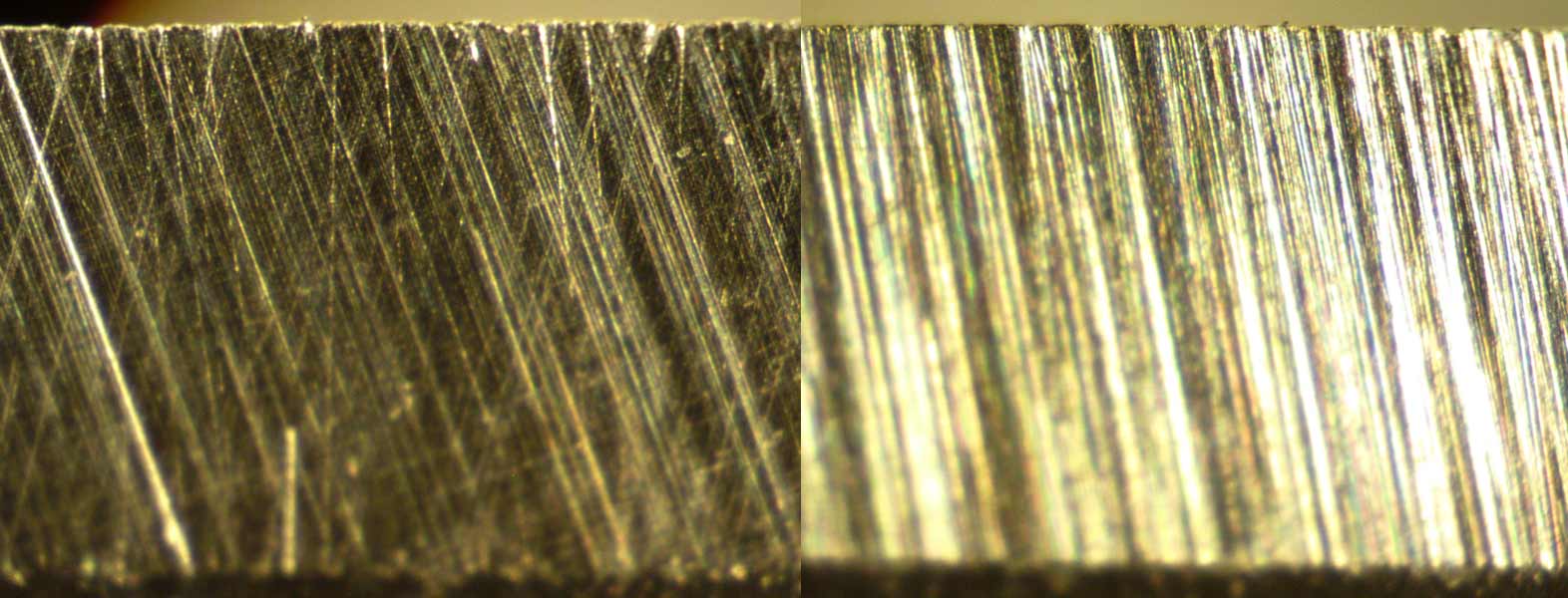
Here is the knife after I am done with the Matrix 300 stone, softer steels don't polish up like this at this point. It is still pretty rough but it sort of shaves even without removing the burrs with something finer. The microscope photos make the scratches look a lot worse.
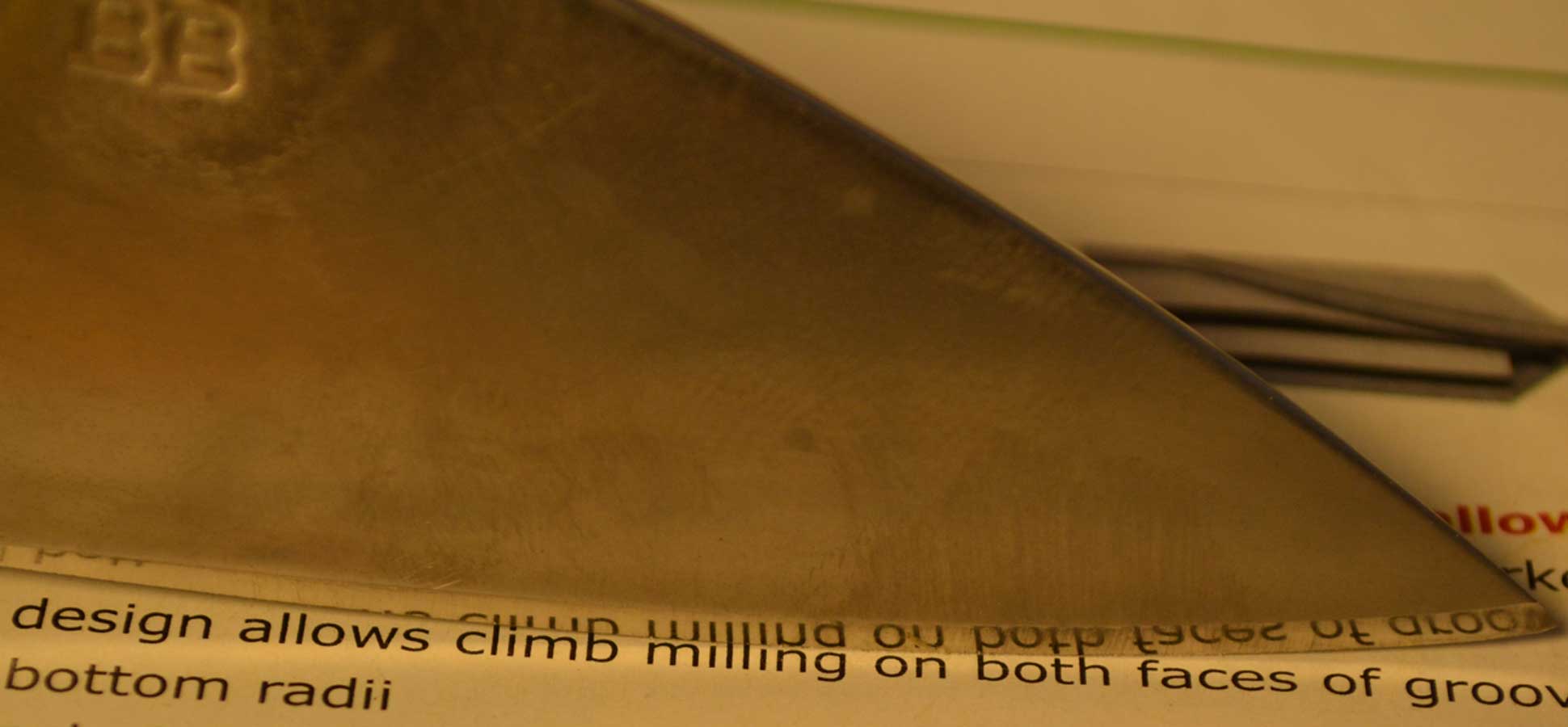
Next I spent about 2 or 3 minutes with the 650. It looks like I could have cleaned up the apex a little better but it turned out this was enough. Burrs are pretty minimal, especially considering I only use edge trailing strokes.

Afte about 2 minutes with the 1100 this is what I got. The apex is starting to look good. Burrs really can't be felt and it is shaving pretty well by now.

On to the 2300 stone for around 2 minutes. Photo are the same except the one on the right is a little higher magnification.

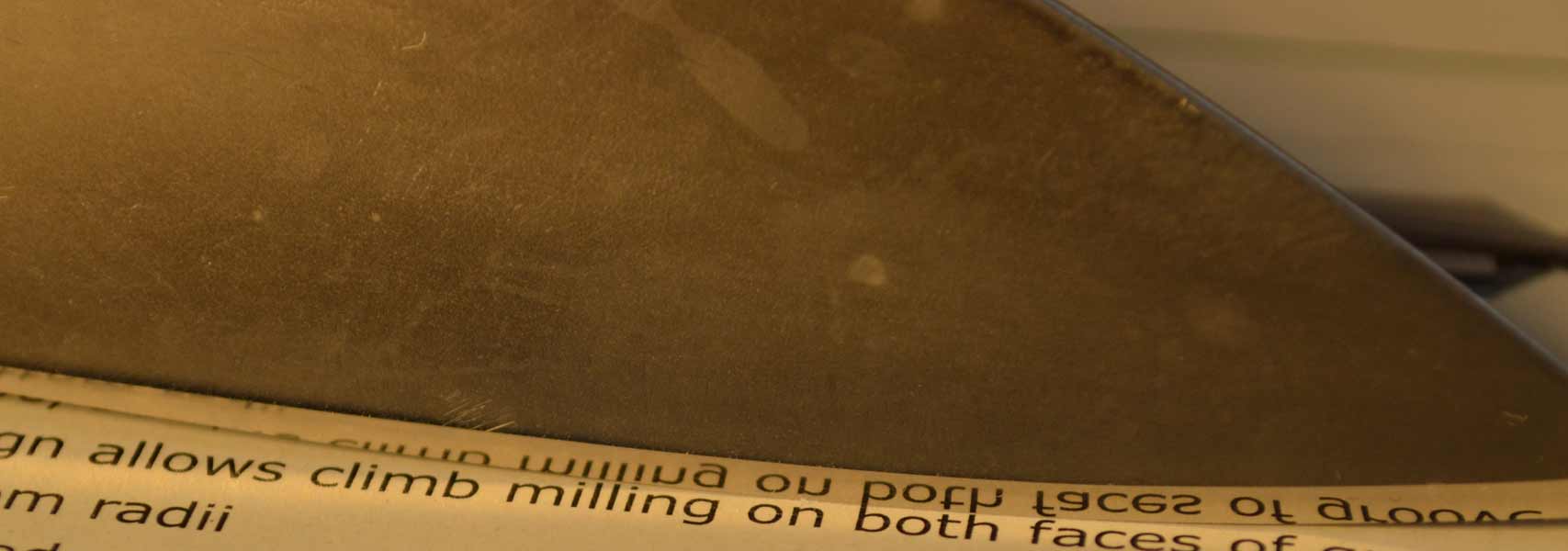
Now for around 2 minutes with the 4000 stone. This is where I should have stopped, but I have to find out the hard way. Again the photo on the right is just better magnification. If you look closely you can see the same debris in both photos.

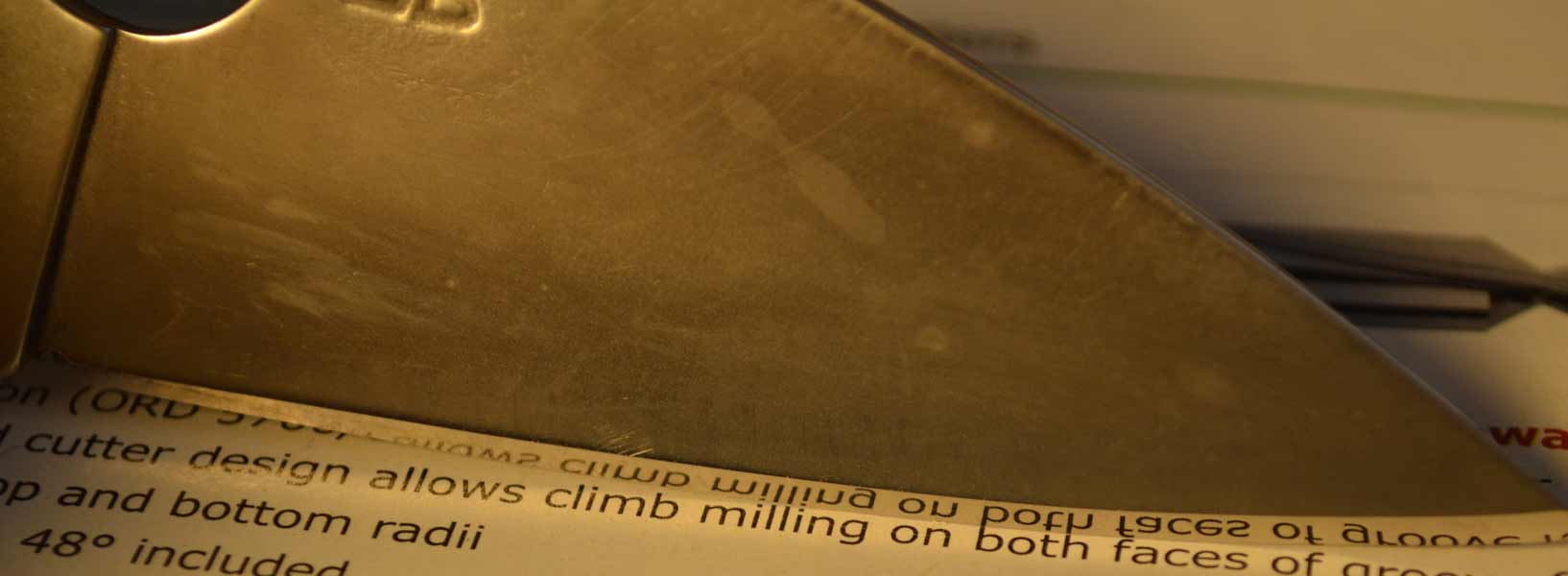
2 minutes with the 9k stone, I don't have a 6500 right now so this is the next step. As you can see it is not working very well. Although it works for most of the surface there are a few deeper scratches.

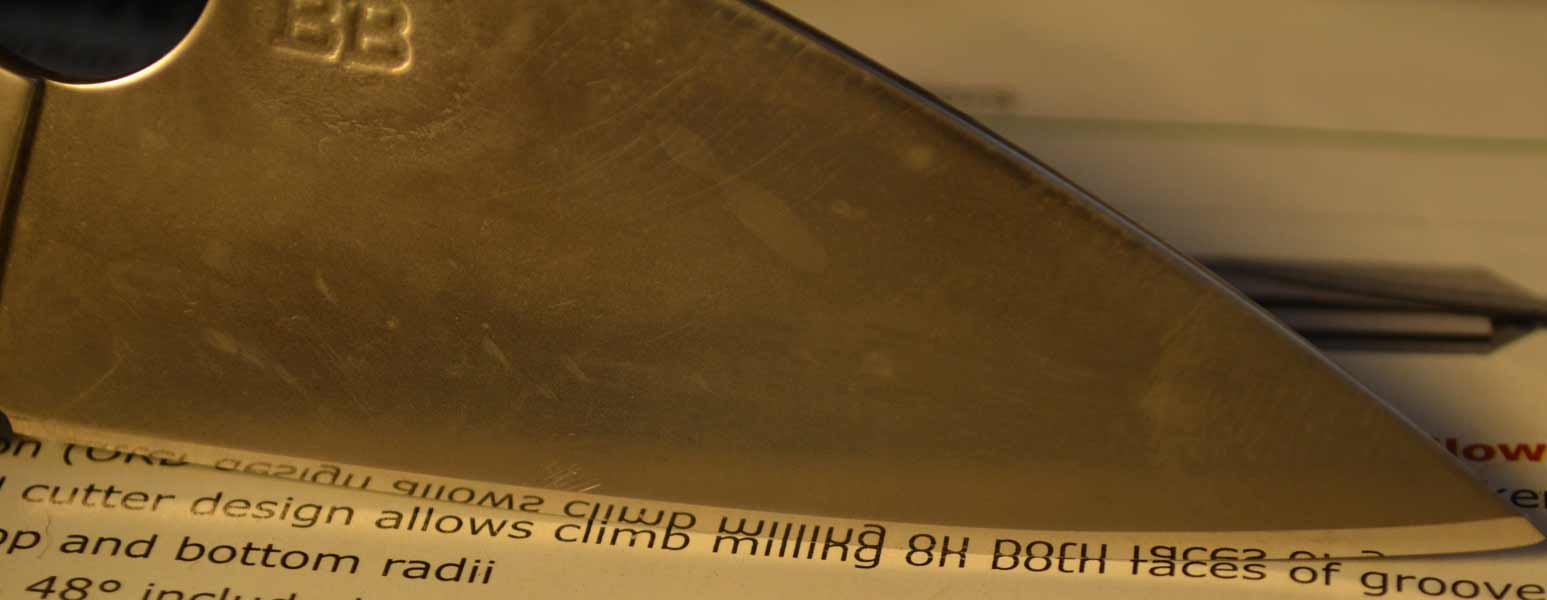
Here is the blade after the 9k stone and around 5 passes with a 4k, 5 micron, diamond loaded denim strop. It looks like all the strop did was roughen the apex, obviously the diamond was too coarse for this.

The last things I did was finish the knife off with the 4k stone to remove the scratches and then I stropped with a 4k alox loaded denim strop. I was running out of time so I failed to take any photos but the alox strop did smooth the apex just as I was looking for.
Thanks again to DeadboxHero for letting me have this knife for a few days so I could sharpen it. This is the first time I have sharpened anything harder than 440c ish blades, other than ceramic. Short version is it's a little slow to set the bevel but once that is done the rest goes just a bit slower than what I am used to. The finished results are spectacular!!!! I flat LOVE this steel. VERY hard, fine grained, and pretty much no microchipping which I find interesting since I usally have some with my other knives if I am not careful.
Ok, now the long version. I started out setting my Apex at 21 degrees and began grinding away with a little pressure, about double the weight of the stone and arm, with bidirectional strokes. Before I reached the apex I tried a 320 Alox stone just to see for myself what it would do, which was nothing. Back to the Matrix 300 but once I started rasing a burr I noticed some damage at the apex with coresponding scratches in the bevel so I switched to edge trailing strokes. Once I was getting a burr along the length of the blade I played with getting the best edge possible by using only the weight of the stone and arm and making only 7-10 passes per side of the blade. This made a big difference in the integrity of the apex and the size of the burr, it got really small considering it is a 300 mesh, 80 micon, stone.
Bi-directional passes on the right, edge trailing on the left. Notice the scratches leading to the edge damage on the bi-directional passes from edge leading strokes. This is pretty common, in my experience, which is why I use edge trailing strokes. The bevel is about .075" wide.

Here is the knife after I am done with the Matrix 300 stone, softer steels don't polish up like this at this point. It is still pretty rough but it sort of shaves even without removing the burrs with something finer. The microscope photos make the scratches look a lot worse.

Next I spent about 2 or 3 minutes with the 650. It looks like I could have cleaned up the apex a little better but it turned out this was enough. Burrs are pretty minimal, especially considering I only use edge trailing strokes.

Afte about 2 minutes with the 1100 this is what I got. The apex is starting to look good. Burrs really can't be felt and it is shaving pretty well by now.

On to the 2300 stone for around 2 minutes. Photo are the same except the one on the right is a little higher magnification.


Now for around 2 minutes with the 4000 stone. This is where I should have stopped, but I have to find out the hard way. Again the photo on the right is just better magnification. If you look closely you can see the same debris in both photos.


2 minutes with the 9k stone, I don't have a 6500 right now so this is the next step. As you can see it is not working very well. Although it works for most of the surface there are a few deeper scratches.


Here is the blade after the 9k stone and around 5 passes with a 4k, 5 micron, diamond loaded denim strop. It looks like all the strop did was roughen the apex, obviously the diamond was too coarse for this.

The last things I did was finish the knife off with the 4k stone to remove the scratches and then I stropped with a 4k alox loaded denim strop. I was running out of time so I failed to take any photos but the alox strop did smooth the apex just as I was looking for.
Last edited:
DeadboxHero
Knifemaker / Craftsman / Service Provider
- Joined
- Mar 22, 2014
- Messages
- 5,444
Review of sharpening a Spyderco Maxamet knife with the Matrix stones.
Thanks again to DeadboxHero for letting me have this knife for a few days so I could sharpen it. This is the first time I have sharpened anything harder than 440c ish blades, other than ceramic. Short version is it's a little slow to set the bevel but once that is done the rest goes just a bit slower than what I am used to. The finished results are spectacular!!!! I flat LOVE this steel. VERY hard, fine grained, and pretty much no microchipping which I find interesting since I usally have some with my other knives if I am not careful.
Ok, now the long version. I started out setting my Apex at 21 degrees and began grinding away with a little pressure, about double the weight of the stone and arm, with bidirectional strokes. Before I reached the apex I tried a 320 Alox stone just to see for myself what it would do, which was nothing. Back to the Matrix 300 but once I started rasing a burr I noticed some damage at the apex with coresponding scratches in the bevel so I switched to edge trailing only strokes. Once I was getting a burr along the length of the blade I played with getting the best edge possible by using only the weight of the stone and arm and making only 7-10 passes per side of the blade. This made a big difference in the integrity of the apex and the size of the burr, it got really small considering it is a 300, 80 micon, stone.
Bi-directional passes on the right, edge trailing on the left. Notice the scratches leading to the edge damage on the bi-directional passes from edge leading strokes. This is pretty common, in my experience, which is why I use edge trailing strokes. The bevel is about .075" wide.

Here is the knife after I am done with the Matrix 300 stone, softer steels don't polish up like this at this point. It is still pretty rough but it sort of shaves even without removing the burrs with something finer. The microscope photos make the scratches look a lot worse.

Next I spent about 2 or 3 minutes with the 650. It looks like I could have cleaned up the apex a little better but it turned out this was enough. Burrs are pretty minimal, especially considering I only use edge trailing strokes.

Afte about 2 minutes with the 1100 this is what I got. The apex is starting to look good. Burrs really can't be felt and it is shaving pretty well by now.

On to the 2300 stone for around 2 minutes. Photo are the same except the one on the right is a little higher magnification.


Now for around 2 minutes with the 4000 stone. This is where I should have stopped, but I have to find out the hard way. Again the photo on the right is just better magnification.
Woops, lost 2 photos, and it's dinner time. I will finish this tonight. Sorry for the delay.
2 minutes with the 9k stone, I don't have a 6500 right now so this is the next step. As you can see it is not working very well. Although it works for most of the surface there are a few deeper scratches.



Now I can sunbathe off my bevel
- Joined
- Mar 26, 2018
- Messages
- 5,453
Sorry for the delay, just got back from my bachelor party.
Tomorrow's the day!!!
I will be using the Edge Pro Diamond Matrix on three knives:
Benchmade Mini Griptilian 555-1 CPM-20CV (59 - 61 hrc)
Spyderco Ladybug ZDP-189 (64 - 65 hrc)
Spyderco Delica Wharncliffe HAP40 (65 - 66 hrc)
Here's the plan.
First I will use the standard silicon carbide 120 grit Edge Pro stone to reprofile all of the knives to a 30 degree inclusive edge (15 degrees per side), which will be the angle I'll be keeping throughout this comparison.
From there I will be using the full range of Diamond Matrix stones, from 250 all the way to the 6500 on both the Benchmade 555-1 and Spyderco Delica to get a good feel for the Diamond Matrix stones.
I will then check to see how the knives respond to stropping after the 6500 stone. I might also strop them after the 1000 stone to see how they respond with a "toothier" finish.
The comparison part will come next. I'd like to have two of the same knives, with the same steel for this, but I guess even then the results could differ because of the heat treats. Anyways I'll be using the Spyderco Ladybug for the comparison. First I'm going to sharpen the Ladybug with the full range of standard Edge Pro stones and polishing tapes, stopping after each stone to take pictures and jot down some some notes. I'll also be checking how the Ladybug responds to stropping after using the final polishing tape. I may also check to see how the Ladybug responds to stropping after the final stone.
I'll be using the following Edge Pro stones for this; 220, 320, 400, 600, 800, 1000. And I'll be using the 2000, 3000, and 6000 grit polishing tapes.
Then I will take the Ladybug back down to a 120 grit finish and start over with the; 250, 300, 600, 1100, 2300, 4000, and 6500 Matrix Diamond stones. I will then see how the Ladybug responds to stropping after the 6500 stone. I may also check to see how the knife responds to stropping after the 1100 stone.

Tomorrow's the day!!!
I will be using the Edge Pro Diamond Matrix on three knives:
Benchmade Mini Griptilian 555-1 CPM-20CV (59 - 61 hrc)
Spyderco Ladybug ZDP-189 (64 - 65 hrc)
Spyderco Delica Wharncliffe HAP40 (65 - 66 hrc)
Here's the plan.
First I will use the standard silicon carbide 120 grit Edge Pro stone to reprofile all of the knives to a 30 degree inclusive edge (15 degrees per side), which will be the angle I'll be keeping throughout this comparison.
From there I will be using the full range of Diamond Matrix stones, from 250 all the way to the 6500 on both the Benchmade 555-1 and Spyderco Delica to get a good feel for the Diamond Matrix stones.
I will then check to see how the knives respond to stropping after the 6500 stone. I might also strop them after the 1000 stone to see how they respond with a "toothier" finish.
The comparison part will come next. I'd like to have two of the same knives, with the same steel for this, but I guess even then the results could differ because of the heat treats. Anyways I'll be using the Spyderco Ladybug for the comparison. First I'm going to sharpen the Ladybug with the full range of standard Edge Pro stones and polishing tapes, stopping after each stone to take pictures and jot down some some notes. I'll also be checking how the Ladybug responds to stropping after using the final polishing tape. I may also check to see how the Ladybug responds to stropping after the final stone.
I'll be using the following Edge Pro stones for this; 220, 320, 400, 600, 800, 1000. And I'll be using the 2000, 3000, and 6000 grit polishing tapes.
Then I will take the Ladybug back down to a 120 grit finish and start over with the; 250, 300, 600, 1100, 2300, 4000, and 6500 Matrix Diamond stones. I will then see how the Ladybug responds to stropping after the 6500 stone. I may also check to see how the knife responds to stropping after the 1100 stone.

Last edited:
Fixall, by all means try the 6500 but inspect your bevels closely before stropping as you may want to drop back down to the 4000 before doing so, it just depends on your steel. I am pretty curious about how the stones look after loonybin tried them out. If you get a chance please post or email me a photo showing the resin side.
You should only need either the 250 or 300, there is no need to use both. Which one works best just depends on the steel, but I think more often than not it is the 250 unless your just touching up. I also think you have a few too many of the EP stones. If your starting with the 120 I think the 220, 400, and 800 are not needed, unless your steel is so hard they struggle to cut it.
You should only need either the 250 or 300, there is no need to use both. Which one works best just depends on the steel, but I think more often than not it is the 250 unless your just touching up. I also think you have a few too many of the EP stones. If your starting with the 120 I think the 220, 400, and 800 are not needed, unless your steel is so hard they struggle to cut it.
Comparison with Matrix stones and Venev diamond stones. The test knife was a CRKT 440c blade with a .06" bevel.
So I got to try a few Venev diamond stones that somebody sent EP to check out. The stones I got to try out are the F80, F150, F400, F1200, and F2000, which are 180 micron, 75, 17, 3, and 1.2. The Venev stones need a lot more pressure to work, pretty much the same as aluminum oxide. In fact the coarsest 2 stones didn't seem to cut much at all with light to medium pressure and it's not like the steel I was grinding on is all that hard. The feedback I thought was excellent. The biggest issue I found was with the aluminum backs, the bevels on the ends were around 32 degrees that came to a sharp edge, they are supposed to be 45 degrees with a flat on the end.
I was mainly interested in metal removal and scratch pattern, I really wasn't interested in refining the apex which is pretty obvious in the photos.
First off is the F80 at 180 microns. I thought this stone was too coarse. It didn't remove metal as fast as the F150 but left deeper scratches. Even when pressing down with about 4 or 5 lbs of pressure it didn't cut very well. The stone didn't look or feel like it needed to be dressed.

The F150 at 75 microns was my favorite stone. It removed metal about 3-4 times faster than the F80 did. I think for metal removal it is a bit better than the Matrix 250, which is 80 microns. The only downside is it created a very large burr when I apexed, around 5 times bigger than the Matrix 250. Since this stone didn't cut with reduced pressure it was hard to avoid the big burr. Matrix on the left, Venev on the right.

The F400 at 17 micron left deeper scratches, was slower cutting, left a larger burr and didn't have as refined a scratch pattern as the 1100 Matrix, which is also 17 micron. Matrix on the left, Venev on the right.

The F1200 is 3 micron but left a coarser finish than the Matrix 2300. Again I didn't think this stone cut as quickly as the Matrix stones that leave a similar scratch depth.

The F2000 is supposed to be a 1.2 micron but the scratches left were closest to the Matrix 2300 which is an 8 micron stone. As before it didn't cut as fast as the Matrix, it left a larger burr and I don't think the scratch pattern was quite as good. Matrix on the left, Venev on the right.
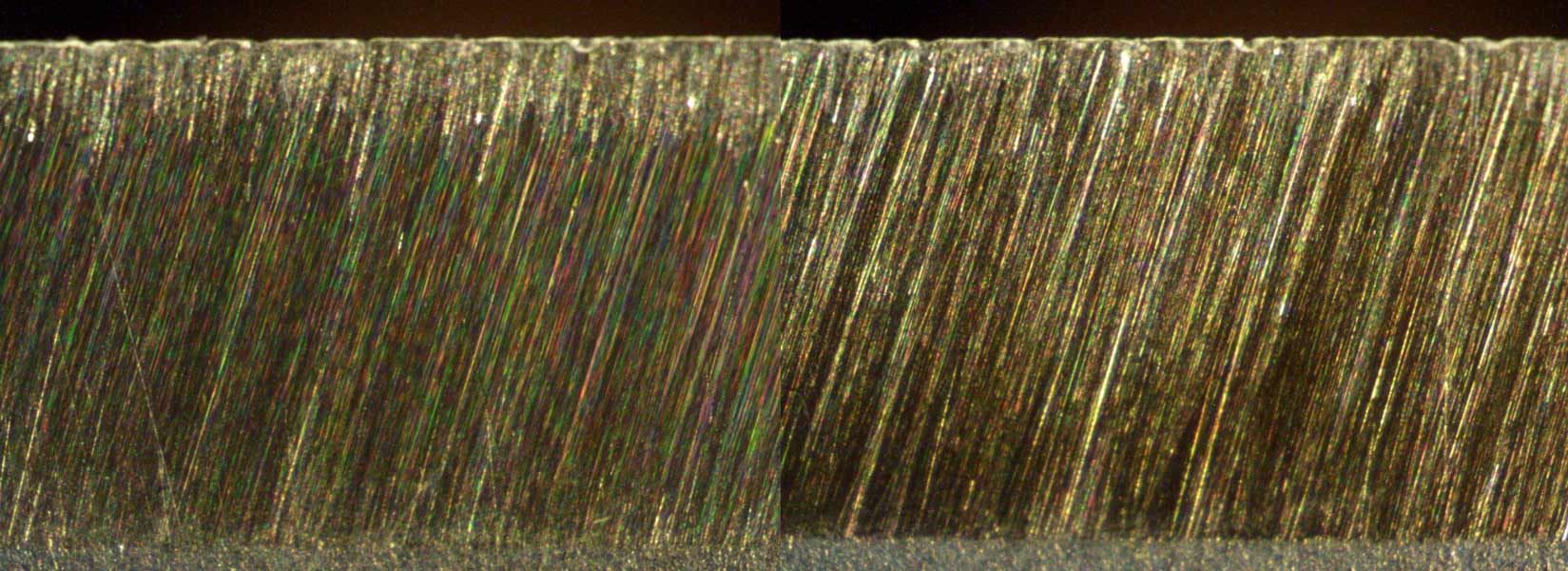
Same stones after dressing with different light. Matrix on the left, Venev on the right.

All in all I am happy how the Matrix stones compared with the Venev stones. The only Venev stone I liked better was the F150, which I am very impressed with. So much so that I am going to try making some phenolic resin stones too.
Update - In the end, I stuck with my original resin but added a 180 micron stone, the 80 grit, to fill in the gap at the coarse end. The Matrix 80 grit removes WAY more metal than the 250 but is dangerously coarse, as in it will create scratches above the bevel where the stone isn't contacting the blade. Don't try it out for the first time on a blade where cosmetics are important.
So I got to try a few Venev diamond stones that somebody sent EP to check out. The stones I got to try out are the F80, F150, F400, F1200, and F2000, which are 180 micron, 75, 17, 3, and 1.2. The Venev stones need a lot more pressure to work, pretty much the same as aluminum oxide. In fact the coarsest 2 stones didn't seem to cut much at all with light to medium pressure and it's not like the steel I was grinding on is all that hard. The feedback I thought was excellent. The biggest issue I found was with the aluminum backs, the bevels on the ends were around 32 degrees that came to a sharp edge, they are supposed to be 45 degrees with a flat on the end.
I was mainly interested in metal removal and scratch pattern, I really wasn't interested in refining the apex which is pretty obvious in the photos.
First off is the F80 at 180 microns. I thought this stone was too coarse. It didn't remove metal as fast as the F150 but left deeper scratches. Even when pressing down with about 4 or 5 lbs of pressure it didn't cut very well. The stone didn't look or feel like it needed to be dressed.

The F150 at 75 microns was my favorite stone. It removed metal about 3-4 times faster than the F80 did. I think for metal removal it is a bit better than the Matrix 250, which is 80 microns. The only downside is it created a very large burr when I apexed, around 5 times bigger than the Matrix 250. Since this stone didn't cut with reduced pressure it was hard to avoid the big burr. Matrix on the left, Venev on the right.

The F400 at 17 micron left deeper scratches, was slower cutting, left a larger burr and didn't have as refined a scratch pattern as the 1100 Matrix, which is also 17 micron. Matrix on the left, Venev on the right.

The F1200 is 3 micron but left a coarser finish than the Matrix 2300. Again I didn't think this stone cut as quickly as the Matrix stones that leave a similar scratch depth.

The F2000 is supposed to be a 1.2 micron but the scratches left were closest to the Matrix 2300 which is an 8 micron stone. As before it didn't cut as fast as the Matrix, it left a larger burr and I don't think the scratch pattern was quite as good. Matrix on the left, Venev on the right.

Same stones after dressing with different light. Matrix on the left, Venev on the right.

All in all I am happy how the Matrix stones compared with the Venev stones. The only Venev stone I liked better was the F150, which I am very impressed with. So much so that I am going to try making some phenolic resin stones too.
Update - In the end, I stuck with my original resin but added a 180 micron stone, the 80 grit, to fill in the gap at the coarse end. The Matrix 80 grit removes WAY more metal than the 250 but is dangerously coarse, as in it will create scratches above the bevel where the stone isn't contacting the blade. Don't try it out for the first time on a blade where cosmetics are important.
Last edited:
Thoughts on two Poltava metal bond CBN stones. The knife is a CRKT 440c with a .06" bevel.
Thanks to DeadboxHero for letting me try his F280 and F500 Poltava CBN stones. They are 36.5 and 12.8 micron in a copper bond. I am not impressed with the bond. It is a bit difficult to dress, doesn't hold onto the CBN particularly well and I wasn't fond of the feedback. I dressed both stones with the 55 micron aluminum oxide on a flat plate that EP uses for the Matrix stones with good results. You can see how well it works by how shinny the surface of the stone is, or isn't, as well as the scratch pattern it leaves on a knife and feedback. I think the aluminum oxide works better than silicon carbide because the silicon carbide breaks down faster. Anyway they responded well to dressing but the boost in performance was short lived. Between the Venev diamond stones and these I liked the Venev better because they were a little more aggressive with metal removal and I liked their feedback better.
This photo shows the Matrix 650 on the left, the freshly dressed F280 in the middle, and the F280 before dressing.

This is what the F500 looks like. Pretty much the same as the Matrix 1600, which is 12 micron as well.

I am currious what DeadboxHero has to say about these stones when he posts his opinion of the set of Matrix stones I lent him. My impression of these stones is not positive but that is just my opinion, please don't take it as definitive, just food for thought.
Edit 1 - I was talking with DeadboxHero about a few things last night and he mentioned he figured out how to dress these stones and feels they work much better now. Once he has some more use and is sure about his dressing method, and I have is ok, I will describe it here.
Thanks to DeadboxHero for letting me try his F280 and F500 Poltava CBN stones. They are 36.5 and 12.8 micron in a copper bond. I am not impressed with the bond. It is a bit difficult to dress, doesn't hold onto the CBN particularly well and I wasn't fond of the feedback. I dressed both stones with the 55 micron aluminum oxide on a flat plate that EP uses for the Matrix stones with good results. You can see how well it works by how shinny the surface of the stone is, or isn't, as well as the scratch pattern it leaves on a knife and feedback. I think the aluminum oxide works better than silicon carbide because the silicon carbide breaks down faster. Anyway they responded well to dressing but the boost in performance was short lived. Between the Venev diamond stones and these I liked the Venev better because they were a little more aggressive with metal removal and I liked their feedback better.
This photo shows the Matrix 650 on the left, the freshly dressed F280 in the middle, and the F280 before dressing.

This is what the F500 looks like. Pretty much the same as the Matrix 1600, which is 12 micron as well.

I am currious what DeadboxHero has to say about these stones when he posts his opinion of the set of Matrix stones I lent him. My impression of these stones is not positive but that is just my opinion, please don't take it as definitive, just food for thought.
Edit 1 - I was talking with DeadboxHero about a few things last night and he mentioned he figured out how to dress these stones and feels they work much better now. Once he has some more use and is sure about his dressing method, and I have is ok, I will describe it here.
Last edited:
Just an update of sorts. I got some samples of 80 and 125 micron boron carbide to try out so I made 3 stones of each grit in different concentrations. The first steel I tried them on was CPM 4V at 64 rockwell and didn't like them, they didn't bite into the steel like the diamond stones do. A day later I went to a friends house for dinner and took my stuff to sharpen her knives since they were all about as sharp as old butter knives. All she has are Cuisinart knives so I tried out standard EP alox stones, Matrix stones, and these boron carbide stones. Funny thing is I like the boron carbide best for these knives, they work very well on the softer steel. Next I will have to try them out on a 440c knife I have to see what I think of them with steel of that hardness. No idea where this will go but I will be sending some off to add to the pass-around kit to see what others think of them.
Next up is a 110 micron diamond stone, the 300 Matrix is 80 micron, and for stock removal is works better. I will be trying out some coarser grits to see how coarse I can go before the performance drops off.
Last are some leather strops I made. This is just some .085" thick vegetable tanned cow hide I got from McMasterCarr. I tried bare, loaded dry with 2.5 micron diamond powder, and waxed with 2.5 micron diamond powder. I liked the dry with diamond powder best and it is definitly a possible next step beyond the 4000 stone. After stropping the edges are noticeably sharper, just don't do more than 2-3 passes. Next step is to try some finer diamond powder because the 2.5 micron is too small a step after the 4000 stone.

Next up is a 110 micron diamond stone, the 300 Matrix is 80 micron, and for stock removal is works better. I will be trying out some coarser grits to see how coarse I can go before the performance drops off.
Last are some leather strops I made. This is just some .085" thick vegetable tanned cow hide I got from McMasterCarr. I tried bare, loaded dry with 2.5 micron diamond powder, and waxed with 2.5 micron diamond powder. I liked the dry with diamond powder best and it is definitly a possible next step beyond the 4000 stone. After stropping the edges are noticeably sharper, just don't do more than 2-3 passes. Next step is to try some finer diamond powder because the 2.5 micron is too small a step after the 4000 stone.

DeadboxHero
Knifemaker / Craftsman / Service Provider
- Joined
- Mar 22, 2014
- Messages
- 5,444
Well, thats good to know
That's what I like about you David, your curious, intelligent and meticulous.
I've noticed that 4V at that hardness was the great impasse for a lot of stones. Having a blend of Vanadium just under 4% and at that 64 HRC was more then alot of stones could handle.
I'm getting in a larger order of CPM 15v and I have more spare pieces of 15v now. I can't think of a better person to get some 15v coupons at 65hrc for testing stones then you.
By the way, I am missing that 300 matrix stone. The feed back was fantastic. Minimal loading.
Still have to share my experience with those stones
-Shawn
That's what I like about you David, your curious, intelligent and meticulous.
I've noticed that 4V at that hardness was the great impasse for a lot of stones. Having a blend of Vanadium just under 4% and at that 64 HRC was more then alot of stones could handle.
I'm getting in a larger order of CPM 15v and I have more spare pieces of 15v now. I can't think of a better person to get some 15v coupons at 65hrc for testing stones then you.
By the way, I am missing that 300 matrix stone. The feed back was fantastic. Minimal loading.
Still have to share my experience with those stones
-Shawn
Just an update of sorts. I got some samples of 80 and 125 micron boron carbide to try out so I made 3 stones of each grit in different concentrations. The first steel I tried them on was CPM 4V at 64 rockwell and didn't like them, they didn't bite into the steel like the diamond stones do. A day later I went to a friends house for dinner and took my stuff to sharpen her knives since they were all about as sharp as old butter knives. All she has are Cuisinart knives so I tried out standard EP alox stones, Matrix stones, and these boron carbide stones. Funny thing is I like the boron carbide best for these knives, they work very well on the softer steel. Next I will have to try them out on a 440c knife I have to see what I think of them with steel of that hardness. No idea where this will go but I will be sending some off to add to the pass-around kit to see what others think of them.
Next up is a 110 micron diamond stone, the 300 Matrix is 80 micron, and for stock removal is works better. I will be trying out some coarser grits to see how coarse I can go before the performance drops off.
Last are some leather strops I made. This is just some .085" thick vegetable tanned cow hide I got from McMasterCarr. I tried bare, loaded dry with 2.5 micron diamond powder, and waxed with 2.5 micron diamond powder. I liked the dry with diamond powder best and it is definitly a possible next step beyond the 4000 stone. After stropping the edges are noticeably sharper, just don't do more than 2-3 passes. Next step is to try some finer diamond powder because the 2.5 micron is too small a step after the 4000 stone.

I refer to Diemaker’s comparison of his matrix diamond stones with Venev diamond stones. I am the person that upon request loaned a new set of Venev stones to Cody at Edge Pro for evaluation. These were new stones, and at the time I was not aware that they needed to be “dressed” before use. Now, I understand that “dressing” means to abrade the surface of the stone to expose the diamonds by abrading away the resin which covers much of the diamonds. So, unless diemaker dressed the Venev stones before testing them, they might be expected to perform suboptimally. I now see that Gritomatic strongly recommends dressing Venev stones before use. Bill
I refer to Diemaker’s comparison of his matrix diamond stones with Venev diamond stones. I am the person that upon request loaned a new set of Venev stones to Cody at Edge Pro for evaluation. These were new stones, and at the time I was not aware that they needed to be “dressed” before use. Now, I understand that “dressing” means to abrade the surface of the stone to expose the diamonds by abrading away the resin which covers much of the diamonds. So, unless diemaker dressed the Venev stones before testing them, they might be expected to perform suboptimally. I now see that Gritomatic strongly recommends dressing Venev stones before use. Bill
As I said in the review I didn't think the stones "needed" dressing. I did try dressing the F150, mostly on the thickest end, but didn't measure any change in the thickness and didn't notice much difference in the way it worked. Granted I was way too conservative when I dressed it to do much since they were someones personal stones and not "test" stones. I have been figuring out that I have been underdressing the coarser Matrix stones. The coarsest Matrix stone, 80 microns, should feel bumpy from the diamonds when it is properly dressed.
Bill, have you tried the Matrix stones yet? If not and you are interested there is a pass-around set that will be available in 2-3 weeks.
Thanks for loaning your stones to EP!
Hey Shawn, Big thank you for the sample piece of CPM 4V to test my stones on. I feel much better grinding away on it instead of my knives testing out the new 150 mesh diamond stone I made. Like you said alox stones pretty much fail to abrade it at all, definitely wouldn't want to try apexing a knife with them. Even my boron carbide stones didn't do much, but the diamond stones cut it just fine, no problems. Looking forward to trying out the 15v and any other pieces you may send me. I have a 250 stone on hand with your name on it and will see what else I can scrounge up. Also a big thank you for the Spyderco Delica 4 with Hap40 that you thinned down, it cuts the ears off boxes like nothing I have ever used. I really like the edge the Hap40 can achieve, which I like to polish to a high gloss.
DeadboxHero
Knifemaker / Craftsman / Service Provider
- Joined
- Mar 22, 2014
- Messages
- 5,444
Hey Shawn, Big thank you for the sample piece of CPM 4V to test my stones on. I feel much better grinding away on it instead of my knives testing out the new 150 mesh diamond stone I made. Like you said alox stones pretty much fail to abrade it at all, definitely wouldn't want to try apexing a knife with them. Even my boron carbide stones didn't do much, but the diamond stones cut it just fine, no problems. Looking forward to trying out the 15v and any other pieces you may send me. I have a 250 stone on hand with your name on it and will see what else I can scrounge up. Also a big thank you for the Spyderco Delica 4 with Hap40 that you thinned down, it cuts the ears off boxes like nothing I have ever used. I really like the edge the Hap40 can achieve, which I like to polish to a high gloss.
Yea, will be interesting to see how they handle this. 15v is the most wear resistant steel available

Hey Shawn, thanks for the LC200N sample. I got to grind on it a little and find it to be an interesting steel! My first impression is it seems more wear resistant to the CPM 4V sample you sent earlier. What are your thoughts? I only got to play with it for 30 minuts so I still have quite a few questions on how exactly to sharpen it. Eventually I will get an apexed edge ground onto these samples but it is going to take a few more sample coarse diamond stones to test, nothing else really cuts this stuff. Can't wait for the 15v sample.
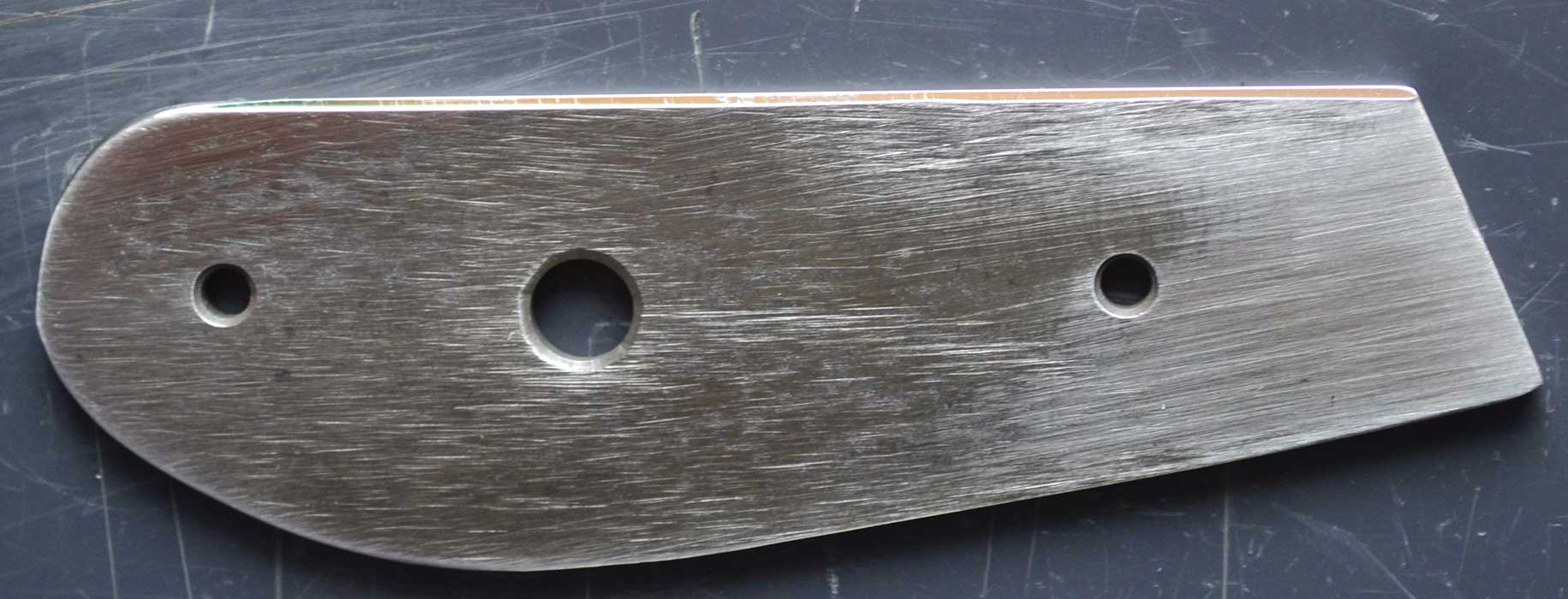

DeadboxHero
Knifemaker / Craftsman / Service Provider
- Joined
- Mar 22, 2014
- Messages
- 5,444
Yea weird huh? It Seemed more difficult to grind then it should on the belts. Maybe chalk it up to geometry for nowHey Shawn, thanks for the LC200N sample. I got to grind on it a little and find it to be an interesting steel! My first impression is it seems more wear resistant to the CPM 4V sample you sent earlier. What are your thoughts? I only got to play with it for 30 minuts so I still have quite a few questions on how exactly to sharpen it. Eventually I will get an apexed edge ground onto these samples but it is going to take a few more sample coarse diamond stones to test, nothing else really cuts this stuff. Can't wait for the 15v sample.

That's Lc200n at 60hrc.
0.3% carbon
0.5% nitrogen
15.0% chromium
0.95 molybdenum
0.5% nickel
It technically should be easier to grind due to the lower alloy, lower hardness and that the nitrides are softer and finer then Carbides.
